

Bullet Journaling. Mind Mapping Software Blog - Visual Thinking Tools, Tips & Insights. Create huge 3D Mind Maps and Concept Maps with InfoRapid KnowledgeBase Builder (Freeware) Schrijfwinkel.com - voor al uw Notitieboeken, Dagboeken, Pennen en Schrijfwaren! Schrijfwinkel.com - voor al uw Notitieboeken, Dagboeken, Pennen en Schrijfwaren! Writersplaza Dagboek Home. Verschillen tussen Leuchtturm1917 en Moleskine. Bij Dudeldopp verkopen wij Leuchtturm1917 notitieboeken voornamelijk omdat wij vinden dat het een goed product is.
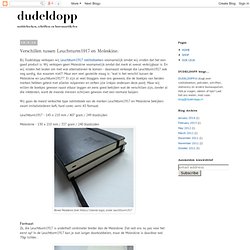
Wij verkopen geen Moleskine voornamelijk omdat dat merk al overal verkrijgbaar is. En wij vinden het leuker om met wat alternatieven te komen - daarnaast verkoopt die Leuchtturm1917 ook nog aardig, dus waarom niet?! Maar een veel gestelde vraag is: "wat is het verschil tussen de Moleskine en Leuchtturm1917? ". Er zijn al veel bloggers voor ons geweest, die de boekjes van beiden merken hebben getest met allerlei vulpennen en stiften (zie linkjes onderaan deze post). Maar wij willen de boekjes gewoon naast elkaar leggen en eens goed bekijken wat de verschillen zijn, zonder al die inkttesten, want de meeste mensen schrijven gewoon met een normale balpen. Wij gaan de meest verkochte type notitieboek van de merken Leuchtturm1917 en Moleskine bekijken: zwart imitatielederen kaft, hard cover, semi A5 formaat.
Voor al uw notitieboeken, pennen en andere schrijfwaren van bekende merken. Home page. Pen Paper Ink Letter Pen Blog, Fountain Pen Blog, Notebook Blog, Pen Reviews, Paper Reviews and More! 17 Small Productivity Habits. The Mini-Habit The idea behind mini habits is that you can get to a larger habit if you start small, create simple goals, and aim for consistency.

In his book Mini Habits: Small Habits, Bigger Results, Stephen Guise gives the example of “The One Pushup Challenge.” He was doing what a lot of us do. Feeling guilty about not working out, he tried to fit years worth of exercise into the first workout which created an all or nothing attitude (not to mention a focus on goals and not process.) Well, one day he decided to do the opposite. In Habit Stacking: 97 Small Life Changes That Take Five Minutes or Less, author S. The core idea behind the mini-habits concept is that you can build a major habit by thinking small enough to get started. Mind Mapping. 50 Tricks to Get Things Done Faster, Better, and More Easily. Time Management Skills Are Stupid. Here's What Works. GTD Cheatsheet – An Intro on the GTD system. The system created by David Allen in his popular book Getting Things Done focuses on freeing up your mind’s RAM (or resources).
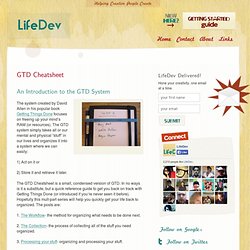
The GTD system simply takes all or our mental and physical “stuff” in our lives and organizes it into a system where we can easily: 1) Act on it or 2) Store it and retrieve it later. The GTD Cheatsheet is a small, condensed version of GTD. “Getting Things Done” The Complete Flake’s Guide to Getting Things Done. Are you smart and motivated and passionate, and have lots of cool things you’d like to get done, but somehow when it comes to doing them, you just . . . don’t?
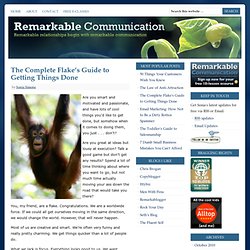
Are you great at ideas but lousy at execution? Talk a good game but don’t get any results? Spend a lot of time thinking about where you want to go, but not much time actually moving your ass down the road that would take you there? You, my friend, are a flake. Congratulations. Most of us are creative and smart. What we lack is focus. That, and we lack this “drive” thing. 43F Recap: Best of Getting Things Done. 30-Second Productivity Strategies. Half a minute is all it takes to make each day more productive. 1.
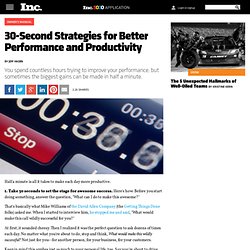
Take 30 seconds to set the stage for awesome success. 6 Things The Most Productive People Do Every Day. Ever feel like you’re just not getting enough done?
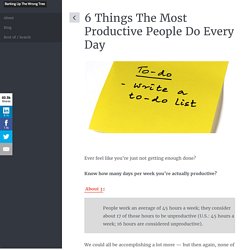
Know how many days per week you’re actually productive? About 3: People work an average of 45 hours a week; they consider about 17 of those hours to be unproductive (U.S.: 45 hours a week; 16 hours are considered unproductive). We could all be accomplishing a lot more — but then again, none of us wants to be a workaholic either. The Brain-Based Secret to Personal Productivity. By now, you've probably already broken most of your New Year's resolutions.
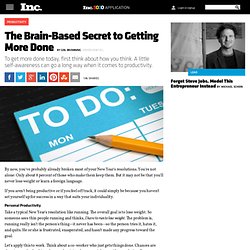
You're not alone: Only about 8 percent of those who make them keep them. But it may not be that you'll never lose weight or learn a foreign language. 50 Tricks to Get Things Done Faster, Better, and More Easily. How to Finish Your Work, One Bite at a Time. “How do you eat an elephant?

One bite at a time.” If you’ve ever ran more than a few miles, you probably understand why you need to pace yourself. Runners that sprint at the start of a race will be exhausted far before they cross the finish line. The same principle applies when trying to get work done. Time Management Tips: How to Find the Right Mindset to Succeed With Time Management.
For the past several years I have worked with time management techniques such as lists, prioritization, planning and so on.

But it wasn’t until I adopted a Quadrant 2 mindset that I really started seeing results. The phrase “Quadrant 2” comes from Stephen Coveys book The 7 Habits of Highly Effective People . One Key To Achieving Goals? Ditch Deadlines, And Make Your Mental Map. If you want to get better at, well, almost anything, it helps to turn to a team that's made it their life's work to break big dreams down into day-sized goals: Everest, the achievement app.

What Everest is brilliant at is taking unruly dreams and disassembling them, so that people can assemble them, step by step, day by day, with their actions. In this way, achieving a goal is really about knowing its anatomy, as COO Katherine Krug tells to us over email: The first step is to build a bridge between where you are at this very moment and where you want to be in the future.
Map out all the things that need to successfully happen to get where you want to go. Write it down or truly visualize it. That's gorgeous: the long-term goal doesn't live in the distant future, but in the present. The Pomodoro Technique® What is The Pomodoro Technique?
EASY for anyone to use! Improves productivity IMMEDIATELY! FUN to do! Why Pomodoro? The Pomodoro Technique isn’t like any other time-management method on the market today. For many people, time is an enemy. Essential to the Pomodoro Technique is the notion that taking short, scheduled breaks while working eliminates the “running on fumes” feeling you get when you’ve pushed yourself too hard. This 15-Minute Activity Will Make You More Successful At Work. The Magic of Doing One Thing at a Time - Tony Schwartz. By Tony Schwartz | 8:53 AM March 14, 2012. 8 Things Everybody Ought to Know About Concentrating.
“Music helps me concentrate,” Mike said to me glancing briefly over his shoulder. Mike was in his room writing a paper for his U.S. History class. On his desk next to his computer sat crunched Red Bulls, empty Gatorade bottles, some extra pocket change and scattered pieces of paper. In the pocket of his sweat pants rested a blaring iPod with a chord that dangled near the floor, almost touching against his Adidas sandals. On his computer sat even more stray objects than his surrounding environment. Mike made a shift about every thirty seconds between all of the above. 5 Ways to Make Your To-Do Lists More Effective. To-do lists seem pretty straightforward: A list of all of the tasks you plan to accomplish during any given day or week. And, really, there are few things more satisfying than drawing lines through each entry. Progress! But, many times, they balloon to unrealistic levels, and we end up feeling overwhelmed and ineffective.
That’s usually because we’re using them as a catch-all for every task that’s thrown at us. Instead, our lists should be derived from our larger goals and include tasks that move us toward those big-picture endeavors, says Robert C. 1.